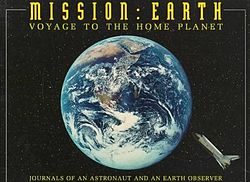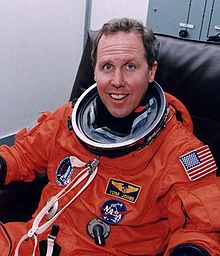- Mission: Earth, Voyage to the Home Planet
-
For other uses, see Mission Earth.
Mission: Earth 
Book coverAuthor(s) June A. English, Thomas David Jones Country United States Language English Subject(s) Human spaceflight Genre(s) Non-fiction Publisher Scholastic Publication date 1996 Media type Hardback Pages 40 ISBN 0590485717 OCLC Number 32464949 Followed by The Scholastic Encyclopedia of the U.S. at War (1998) Mission: Earth, Voyage to the Home Planet is a children's literature book by science writer June A. English and astronaut Thomas David Jones. It was published in 1996 by Scholastic. The book chronicles the NASA space mission of Jones, which began April 1994, with contextual background information provided by English. Jones was among the crew members of the Space Shuttle Endeavour, during an eleven day mission in Space to study the ecology well-being of planet Earth utilizing specialized radar technology. Radar images and picturesque photographs help to illustrate the account given by Jones throughout the work.
The book received a generally favorable reception in media coverage and from book reviewers. The Pittsburgh Post-Gazette noted, "The authors convey the awe and wonderment of seeing Earth from space and the intricate delicacy of the Earth's ecology."[1] The Dallas Morning News observed, "The astronaut's descriptions are vivid."[2] A review in Booklist was more critical, "The authors try to cover too much in so few pages, and the narrative, with several focal points, becomes simplified at times."[3] School Library Journal wrote, "It provides a unique look at a new method of research and an opportunity for youngsters to read one scientist's account of what it's like to engage in this exciting field of endeavor."[4] It was selected for inclusion in books Best Books for Children,[5] and Adventuring With Books,[6] or educating youths about history by using children's literature works.
Contents
Authors
June A. English is an author with a specialty in the field of science writing.[7] She has published works within the genre of children's literature.[8]
Thomas David Jones was a member of the United States Air Force prior to his service working for NASA.[8] As Jones was a United States federal employee at the time of the book's publication, he did not receive profits from sales of the work.[2] English and Jones would later go on together to produce another collaborative work, Scholastic Encyclopedia of the United States at War, published in 1998.[9][10] Jones authored another book about his experiences in space, Sky Walking: An Astronaut's Memoir, published in 2006.[10][11]
Contents
In the work, astronaut Thomas David Jones recounts for the reader his experiences studying planet Earth during his first mission with the space agency NASA.[12] English gives the reader contextual information regarding Jones' mission during this time period.[13] Jones was a member of the crew of the Space Shuttle Endeavour, which departed Earth in April 1994.[14] Jones writes descriptively of his observations while looking at the Earth from Space, for example upon viewing lightning occurring on the planet, he recalls: "Maybe more than any other sight from space, lightning gives the decided impression that the Earth is alive, a living organism."[15] Aurora phenomenon is described in the book as, "shimmering fingers of green light reaching up from the dark ocean, an arc of light around the South Magnetic Pole."[2]
 Thomas David Jones (1996)
Thomas David Jones (1996)
His journey lasted eleven days.[16] The book was based upon journal entries written by Jones during his time on the mission.[2] A typical NASA mission member's day-to-day experiences while living on the space shuttle are presented.[4] The mission intended to provide the Space Radar Lab with a view of the planet.[14] By utilizing three separate radar echoes, scientists were able to analyze a full image of the planet.[14] The radar technology was able to penetrate obstructions including clouds and thick outgrowth of trees.[14] Another purpose of the mission was to analyze the ecological state of the planet.[15] In addition to the radar technology, a separate device was utilized in order to take measurements of pollution on the Earth caused by carbon monoxide.[15] Jones provides the reader with detailed imagery to assist in his account, including photographs from his mission, and pictures from the radar capture.[14]
Reception
Mission: Earth, Voyage to the Home Planet received positive review from journalist Rebecca O'Connell writing in the Pittsburgh Post-Gazette, who commented, "The authors convey the awe and wonderment of seeing Earth from space and the intricate delicacy of the Earth's ecology."[1] She noted of the descriptive nature of the text, "Their descriptions of scientific phenomena read like revelations of mystic wonders. But this is not to say it is ponderous, not at all."[1] O'Connell's review concluded, "The text is packed with fascinating information and humorous touches. Even children who are not ordinarily interested in space or ecology will be interested in this book, and aficionados will go ga-ga."[1] Leigh Fenly of The San Diego Union-Tribune recommended the book, and observed, "Science writer June English tracked the launch and adds perspective on how the mission will help scientists understand Earth, including its atmosphere, geology, ecology -- and future."[15] Nita Thurman wrote for The Dallas Morning News, "Mission: Earth, A Journey to the Home Planet has dozens of color photos taken inside the shuttle and through its windows. The astronaut's descriptions are vivid."[2] Publishers Weekly wrote favorably of the book, "Astronaut Jones's enthusiasm for his work is contagious; it shines through the text, making for a roundly enjoyable and informative read."[17] In their recommendation of the book, Publishers Weekly noted, "Well-conceived and thoughtfully executed, this book deserves a wide audience."[17]
"The authors convey the awe and wonderment of seeing Earth from space and the intricate delicacy of the Earth's ecology."
A review of the book by Ilana Steinhorn in Booklist was more critical, "The authors try to cover too much in so few pages, and the narrative, with several focal points, becomes simplified at times."[3] Steinhorn concluded, "Still, the account is interesting, and the many high-quality, often breathtaking color photographs and radar images complement the text nicely."[3] Elaine Fort Weischedel reviewed the book for School Library Journal, and recommended the book for a specific teaching subject matter, "Pollution patterns, shifting ocean currents, destruction of rain forests, and other environmental changes were the heart of Jones's project, and this book might be used more successfully to supplement the curriculum in those areas than in units on space flight per se."[4] Weischedel observed, "It provides a unique look at a new method of research and an opportunity for youngsters to read one scientist's account of what it's like to engage in this exciting field of endeavor."[4] Horn Book Review characterized the book as, "a uniquely personal account".[13] The review observed, "The book features a crowded design, but the many color photographs throughout the text are fascinating."[13]
The book is listed as a resource for educating youth about history by using children's literature works, in the book by Wanda J. Miller, Teaching U.S. history through children's literature: post-World War II.[14] Additionally, it is utilized in books including Strategies That Work: Teaching Comprehension for Understanding and Engagement by Stephanie Harvey and Anne Goudvis,[18] Reading Comprehension: Books and Strategies for the Elementary Curriculum by Kathryn K. Matthew and Kimberly Kimbell-Lopez,[7] and An Integrated Language Perspective in the Elementary School: An Action Approach by Christine Pappas, Barbara Zulandt Kiefer, and Linda S. Levstik.[19] It was selected for inclusion in books Best Books for Children by John Thomas Gillespie,[5] and Adventuring With Books by Kathryn Mitchell Pierce.[6]
See also
References
- ^ a b c d e O'Connell, Rebecca (November 10, 1996). "Reading that's fun and fundamental". Pittsburgh Post-Gazette: p. G-11. ISSN 1068-624X.
- ^ a b c d e Thurman, Nita (February 4, 1998). "A space odyssey Astronaut shares stories with students in Denton County". The Dallas Morning News (The Dallas Morning News Company): p. 25A.
- ^ a b c Steinhorn, Ilana (October 15, 1996). "Mission: Earth". Booklist (United States: American Library Association) 93: 415. ISSN 0006-7385.
- ^ a b c d Weischedel, Elaine Fort (October 1996). "Mission: Earth". School Library Journal (United States: Library Journals LLC; Media Source, Inc) 42: 130. ISSN 0362-8930.
- ^ a b Gillespie, John Thomas (2001). Best Books for Children: Preschool Through Grade 6 Seventh Edition. Libraries Unlimited. p. 1093. ISBN 0313320683.
- ^ a b Pierce, Kathryn Mitchell (2000). Adventuring With Books: A Booklist for Pre-K-Grade 6. National Council of Teachers. p. 7. ISBN 0814100775.
- ^ a b Matthew, Kathryn I.; Kimberly Kimbell-Lopez (2003). Reading Comprehension: Books and Strategies for the Elementary Curriculum. The Scarecrow Press, Inc. p. 50. ISBN 0810847523.
- ^ a b Pate, Nancy (September 20, 1998). "Feed hunger for war with facts". The Orlando Sentinel (Sentinel Communications Co.): p. F6. ISSN 0744-6055.
- ^ Johnston, Jerry (December 6, 1998). "3 kids' books tell tales of war, heroes". The Deseret News (Salt Lake City, Utah: Deseret News Publishing Company): p. E06. ISSN 0745-4724.
- ^ a b Jones, Thomas D. (2006). Sky Walking: An Astronaut's Memoir. HarperCollins. ISBN 978-0060851521.
- ^ Haynes, Charles D. (July 2006). "Sky Walking". Science Books & Films (United States) 42 (4): 162. ISSN 0098-342X.
- ^ OCLC 32464949
- ^ a b c "Mission: Earth". Horn Book Review (United States: The Horn Book, Inc; Media Source, Inc). 1996.
- ^ a b c d e f Miller, Wanda J. (1998). Libraries Unlimited. pp. 106, 222. ISBN 978-1563085819.
- ^ a b c d Fenly, Leigh (February 16, 1997). "Let shooting comet catch your child's fancy". The San Diego Union-Tribune (Union-Tribune Publishing Co.): p. 5, Section: Books.
- ^ Homa, Linda L.; Ann L. Schreck, Maureen Hoebener (1998). Elementary School Library Collection: A Guide to Books and Other Media, Phases 1-2-3. Brodart Co. pp. 170, 641, 663. ISBN 0872721140.
- ^ a b "Mission: Earth". Publishers Weekly (United States: Reed Business Information, Inc). 1996. ISSN 0000-0019.
- ^ Harvey, Stephanie; Anne Goudvis (2007). Strategies That Work: Teaching Comprehension for Understanding and Engagement. Stenhouse Publishers. p. 319. ISBN 978-1571104816.
- ^ Pappas, Christine; Barbara Zulandt Kiefer, Linda S. Levstik (1998). An Integrated Language Perspective in the Elementary School: An Action Approach. Allyn & Bacon. p. 79. ISBN 0801330556.
Further reading
- English, June A.; Thomas D. Jones (1998). Scholastic Encyclopedia of the United States at War. Scholastic Reference. ISBN 0590634216.
- Jones, Thomas D. (2006). Sky Walking: An Astronaut's Memoir. HarperCollins. ISBN 978-0060851521.
External links
NASA Astronaut Group 13, "The Hairballs", 1990 Pilots Mission Specialists NASA Astronaut Groups · NASA Astronaut Corps Categories:- 1996 books
- Non-fiction books
Wikimedia Foundation. 2010.
